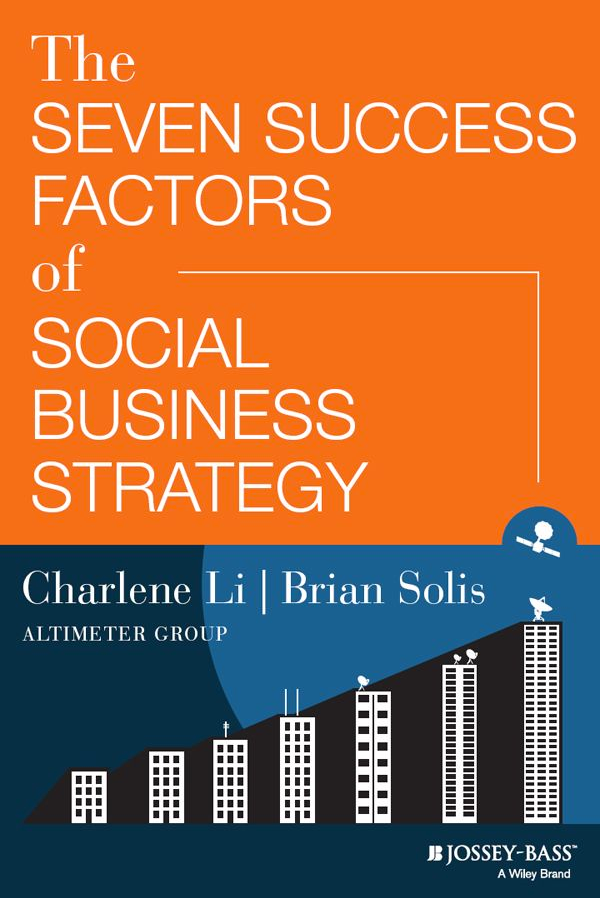Last year, my Altimeter Group colleague Charlene Li and I published a series of research reports on the state and evolution of social business. In our research, we discovered that the most advanced businesses shared seven success factors in developing, launching, and measuring social business strategies. Our friends at Jossey-Bass asked us to turn it into an ebook and that we did!
The Seven Success Factors of Social Business Strategy
During the launch, we were interviewed by the Amazon team to dive deeper into the difference between social media and social business strategies. It also set the stage for our 2014 research track on Digital Transformation (report here.)
I’ve included the Amazon Q&A for you here…
What does it mean to be a social business?
A social business is more than social media and the Likes of Facebook, Twitter, Pinterest, et al. Yet, it’s a term that’s often confused with social media strategy. But, there’s an important difference between a social business and a social media strategy.
Each represent distinct qualities where “social” is simply a qualifier. In front of media, social is an adjective that describes the nature of channels, networks, or platforms that facilitate conversations online. When placed ahead of business, social articulates a philosophy or approach.
In this case, “social business” is a philosophy; a way of business where social technologies supported by new approaches facilitate a more open, engaged, collaborative foundation for how we work.
How do you convince companies to see social media as more than just “a necessary nuisance?”
The fact that social media and social business cause debate or even confusion after all these years is understandable. Many executives see social media as a novelty or a distraction for young adults and kids. They haven’t realized the impact of social networks because they either don’t have time, can’t see the value, find it difficult to keep up with all of the networks, or a combination of all of the above.
Coming back to the differences between social media and social business, it’s important for any social media or digital strategist to learn the language of the C-Suite. In the ebook, we share insights from several top executives to understand what it takes to convince them of the true opportunity that social promises. We heard time and time again that their priority and focus is driving business objectives, creating opportunities and solving problems. They don’t make decisions based on technology or trends, yet strategists tend to emphasize social media rather than business goals.
A social media strategy outlines how a business will employ social networks to engage customers or employees.
A social business strategy starts with a vision for how social media will improve customer and employee experiences and relationships and therefore aligns social media initiatives with business goals and opportunities. Technology thus becomes an enabler for a bigger mission and purpose.
Executives asked that we take into consideration a day in their life. They report to stakeholders and sometimes shareholders. They are measured on business performance. If you do your homework to understand their priorities and align social with business objectives, you’ll earn their attention. Add to that, customer expectations, preferences, and the opportunities and challenges with each and how you can help solve against them. By presenting social in this light, executives can’t help but at least support further research and ultimately pilot programs that lead to bigger initiatives.
In the end, you learn that a true social business strategy employs social as one of the primary channels, not the only channel, to deliver a consistent, connected, and additive experience online, through mobile and in the real world by modernizing and improving the complete customer and employee lifecycle.
What are some criteria that organizations should use to prioritize their social initiatives?
As mentioned earlier, social media strategies are often sparked by technology or trends. I’ve heard strategists focus on Pinterest because of its popularity not necessarily because there was a clear correlation between Pinterest users, behavior, and business opportunities. This is also true for most popular or emergent platforms.
When you begin with business objectives, social technology and the communities they reach, are evaluated against bona fide priorities that already have the buy-in of executives. In this case we look at business pillars to assess the criteria that contribute to the success of any organization, which can include sales, employee and customer satisfaction, brand resonance, NPS, et al. These pillars represent the primary measures for assessing value in the social business strategy process.
For example, each initiative should be assessed at the functional, line of business, or brand level. From there, ideas must tie together value to the organization (business goals) and also consider the team’s ability to execute. Evaluating ideas this way helps prioritize opportunities while uncovering needs, training, support or assets required to properly execute.
How important is it to get the C-suite on board with social business strategy?
In our research we learned that as social media permeates the enterprise, it typically does so from the marketing or communications department. Usually a social media champion rallies adoption within the organization. As social becomes more prevalent in society, more champions arise throughout the company seeing it as an opportunity to improve how they do things today. As it gains momentum, it creates an internal groundswell that eventually requires budget, resources, training, and governance to support expansion and introduce enterprise-wide standards and goals.
At this point, social usually hits a ceiling that requires executive sponsorship to truly transform how a company views social’s potential. Anyone experienced in change management will understand that systemic transformation occurs from the top-down. Earning buy-in, making the case, tying strategies to business objectives, learning the language of the C-Suite, this is how strategists can earn support and bring about the change they wish to see. This is true for more than social media of course. But in that regard, getting the C-Suite on board is imperative to launching productive social business initiatives.
Why do you recommend a three-year plan? Is that realistic, considering the rate of technology change?
If it’s one thing we can bet on, change is not only necessary, it’s slow to appreciate and ultimately unfold. A three-year plan is far enough out to plot a course for transformation but also tangible in the sense that real programs can be deployed now and over time to the benefit of customers, employees and the bottom line.
Remember, social business isn’t about technology; it’s about attaining goals and objectives by improving relationships, driving transactions, and enhancing experiences through channels of relevance. Technology and channels will always evolve and as such, they become enablers for a higher purpose. This is about the ongoing pursuit of relevance.
Visualizing the DNA of Successful Social Businesses
Via Vala Afshar…

Via Mark Smiciklas…

Connect with me:
Twitter | LinkedIn | Facebook | Google+ |Youtube | Instagram






Brian, you and your readers may like to explore ManageHub.com. It is free, cloud-based social business platform designed for businesses with 1-150 employees. You can access getting started resources here: http://prezi.com/9hfdejbv3gni/?utm_campaign=share&utm_medium=copy&rc=ex0share I hope you like it.
Hi Mike, your tool is very interesting. After watching your presentation Prezi and the various videos, I’m really impressed. My question: what is your interest to offer this type of platform for free? I am not yet subscribed, maybe I would find an answer on this issue if I do it ;-). Another question: Is your platform multilingual?
Hi Martin, I am glad you like the ManageHub resources. Our motivation for providing these services to startups and small businesses for free is found in the set of graphs presented in the first slide labeled “The Problem.”
(Here is a link to the presentation again just in case you need it: http://prezi.com/9hfdejbv3gni/?utm_campaign=share&utm_medium=copy&rc=ex0share )
As you can see, the data shows that the Small Business contribution to GDP and Jobs is falling dramatically. If the trend continues, small business will no longer be the primary engine of national economic growth. As the founder of the SBDC Think Tank we create the Breakthrough Project to identify ways to reverse the trend. We initiated a research study and identified that a significant contributing factor to this decline is what we call the “Management Gap.”
Our research found that most leaders of SMEs think they are building solid companies. But, when we probed further we found that most do not apply event the most basic quality management practice needed to fuel their growth and long term success. These practices include documenting their company’s operational knowhow, engaging their employees in continuous improvement, etc.
We hope to reverse the negative trends by providing startups and SMEs with an easy, free onramp to adopting time-tested quality management practices based upon the U.S. Baldrige Performance Excellence Program. We need the help of the Quality Management community, NGOs, and government agencies to help create awareness about the free ManageHub First Steps program. (We created a separate training program for small business advisers. Anyone interested can email support@managehub.com)
As for your question on language. Several volunteers from around the world are translating the Breakthrough and ManageHub books into other languages. Currently ManageHub Software is English only. However, we would add a language component with funding. We support interested parties starting a Kickstarter.com campaign to fund the project. The cost is about $50,000)
Sorry for the lengthy response. I hope it helped.
Mike Kramer, CPA
Hi Mike, thank you very much for your reponse. Now I think all is clear for me. I’ll check out your platform in the next few weeks, and send you a feedback.
Have a great and successful new week.
Best,
Martin
7 success factors of social business strategy that we can use and learn through practical factors.
Great post and graphics! It’s obvious that social media will continue to have a significant impact on marketers and business owners. Unfortunately, many businesses are still unclear on how social media can help to develop the business. A lot of that has to do with the age/generation of target market of a business that is built on relationships. Although, social media in forms of blogs, social platforms, sites, etc. have the ability to reach out and communicate on a personal level with their target audience on a daily basis, I think the
problem is to see all the versatility of social media. Any business owner can and should use social media. The key is to find or establish that link between customer relationship and
business development.
I agree with many failing to see it’s versatility. It’s too easy for business owners to think that social media is only for certain types of businesses/industries. Although it may vary a lot from what the business next door is doing, there is always a way to incorporate it into your own marketing plan – and every business should be doing so.
Good Work Google+, If you are serious about your writing, Write a Book:
Get Published, Write Now! is as important a tool as your laptop or your
pen. Do yourself a favor, and just buy it.
Some really great points in this, and they all flow into each other really well. Thanks for sharing.